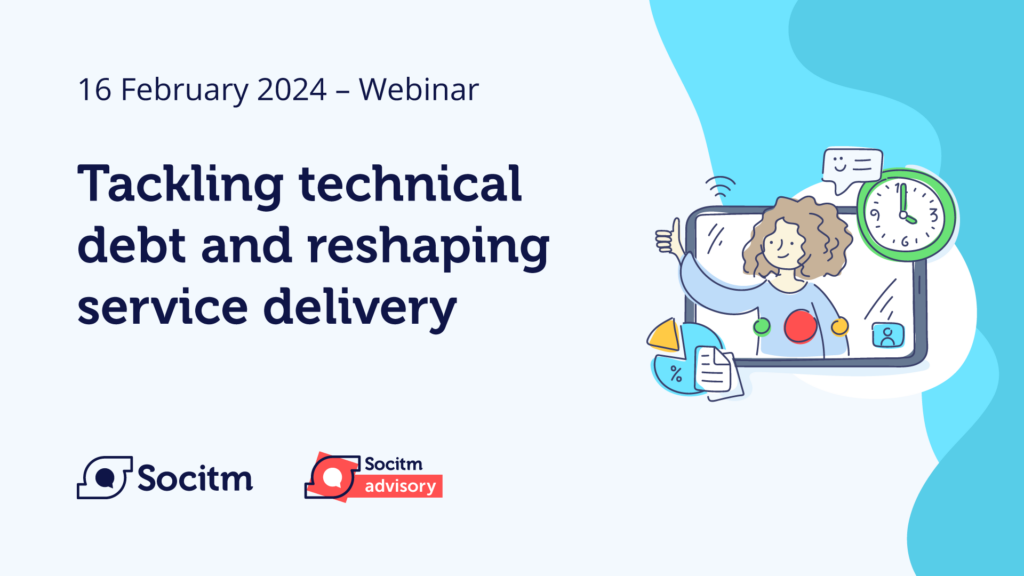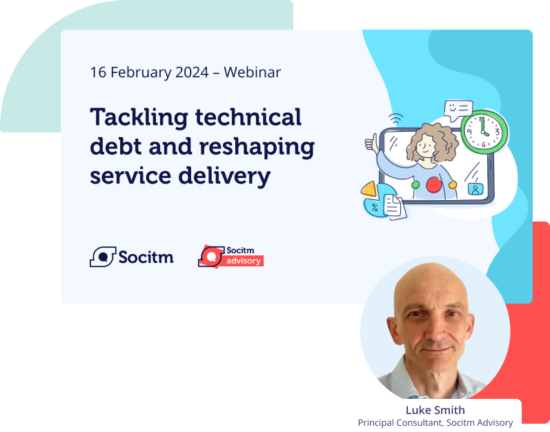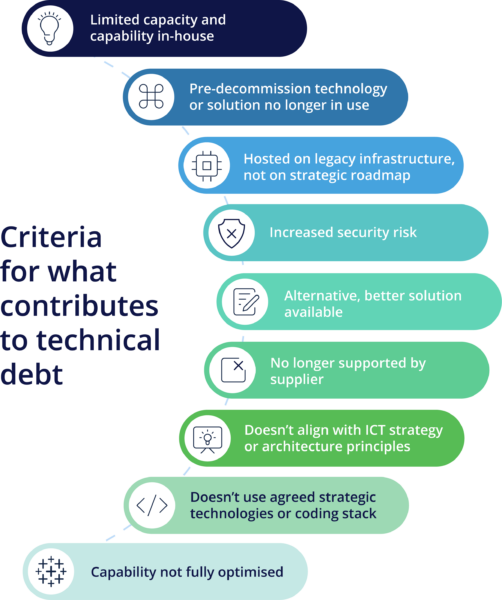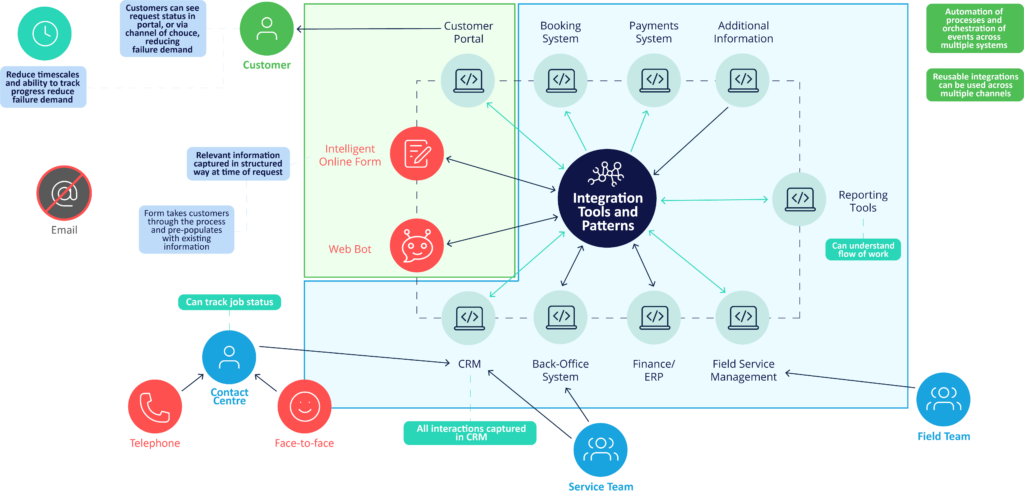In February, Socitm Advisory Principal Consultant, Luke Smith, hosted a Socitm webinar on ‘Tackling technical debt and reshaping service delivery’. In this presentation, he took a deep dive into technical debt and service delivery, looking at the challenges and issues, processes and best practice, as well as the benefits and capabilities of each of these areas.

In this webinar, Luke not only introduced the ideas and solutions around technical debt and redesigning service delivery, but also spoke about a similar project we are currently supporting Aberdeenshire Council with.
Challenges
Technical debt
The introduction and presence of technical debt is inevitable, as the technology landscape evolves and organisations need to be pragmatic in how they respond to that. However, without recognition and management the impact on an organisation’s ability to change can be significant. Councils can be carrying large amounts of technical debt – something which is invisible but has a detrimental effect on increased costs, reduction of agility, and a lack of ability to respond to change.
But what is technical debt? It comes from the implementation, management and/or supporting technology when better strategic options are available; and if the debt is not “repaid” it can lead to a more challenging journey to implement change successfully. It’s imperative that levels of debt are both managed and monitored.
The diagram above shows just some of they key criteria that can contribute to technical debt within your project or programme, including:
- Organisation doesn’t have the necessary skills in-house to provide full support (or limited capacity)
- Technology or solution is no longer in use but hasn’t been decommissioned yet
- Hosted on infrastructure that is considered legacy or isn’t on strategic roadmap (includes OS)
- Increases security risk and not aligned with agreed security framework principles
- There is an alternative strategic solution available that could meet the business need
- System is no longer supported by the supplier (or known date for going out of support)
- Doesn’t align with ICT strategy or architecture principles
- Doesn’t use agreed strategic technologies or coding stack
- Capability not fully optimised using available technologies (i.e. partial implementation)
Service delivery
Councils often suffer from inefficient processes that are expensive to run and negatively impact the customer experience, which has a negative impact on service delivery in terms of overall costs, timescales, and customer satisfaction. Some of the key areas where issues can occur are due to:
- Legacy systems that are built around a particular service and aren’t integrated
- Processes built around systems and not the user need
- And a lack of data around the flow of work, and the cost implications

Recently at Aberdeenshire Council, we have supported the production of high-level process maps that we estimate will save the council between 8% and 15% of their costs, and see a reduction in service delivery times, which leads to a fall in failure demand and improves customer satisfaction.
To be able to realise these benefits we have proposed the implementation of the following:
- A clear vision for digital and strategy, drivers and objectives
- Design processes and governance to ensure consistency and alignment with strategy
- Operating model
- Technical architecture
- Relevant capabilities
Processes
With many of the organisations we work with, often, process architecture is inefficient, with a lack of cohesion and communication between multiple systems and sometimes procured through different suppliers that don’t necessarily work together in the most effective way. For example, multiple different channels of communication used in-cohesively to speak to different systems, i.e. payroll only being able to be contacted via telephone, whilst the Contact Centre cannot receive online forms or emails.
There are a number of issues with these types of inefficiencies within typical processes:
- Different channels collect data in different ways and formats
- Systems don’t talk to each other, leading to manual intervention – increasing time and chance of errors
- Service is designed around the different systems, not from the customer perspective, leading to low customer satisfaction
- Data is managed in siloed off-process systems e.g. spreadsheets
- Cultural hurdles where some services don’t see it as their role to improve processes or systems
- Process isn’t documented and manual elements are handled differently by staff, making it difficult to onboard new staff
- Information management is more difficult and increased risk of data errors
- Reporting and measurement isn’t built into the process, so flow of work is hidden and difficult to report and understand true cost of process
- Due to budget and staff pressures services don’t feel they have the time to work on service design to improve things so just carry on the same
- A lack of understanding of end-to-end service design, and what this is and means for the customer, and for the council teams providing the services
- Having a clear view of all systems and tools available on a council’s IT estate and how to get access to these tools to improve processes; managers don’t know what they can even ask for to improve things, etc.
The efficient process
Below is an example of an efficient process, produced considering how capabilities support design, delivery and continuous improvement.
To achieve this efficient process, we recommend following a six stage design process:
- Service Design – understanding the user need
- Business Analysis – understanding the data requirements
- Process Modelling – mapping the current process
- Integration and Orchestration – integration capabilities
- Automation and Workflow – monitoring the process
- Measurement and Reporting – continuous improvement
Capabilities and benefits
Capability maturity assessment
To be able to optimise an efficient process for your organisation, you first need to understand the capabilities within the current structure, and the required capabilities for the future state, understanding the maturity of these by assessing the following criteria (using the POPIT (Process, Organisation, People, Information Technology) method):
- Process – Do they exist? Do they work? Are they followed?
- Organisation – Are the right structures in place to support the capabilities required?
- People – Are there enough people and they they have the right skills?
- Information Technology – Can you access the right data? Is there enabling technology in place?
Benefits
Once an efficient process has been embedded, these are some of the benefits we have enabled our customers to realise:
- Being led by data – quantitative and qualitative
- The right data to support robust reporting and analytics to spot trends and manage resources in a more dynamic way, in response to demand
- Proactive to user needs rather than reacting to issues
- Application rationalisation
- More efficient processes
- Reduced response time and reduced failure demand
- Better understanding of cost of processes
- Continual improvement
- More flexible and responsive architecture
- Meeting the needs of users – improved customer satisfaction
Using the right tools and approaches can be delivered incrementally, but still takes time and the right strategy.

Ready to have a chat about Service Design? Click here to book a meeting with one of our Account Directors.


